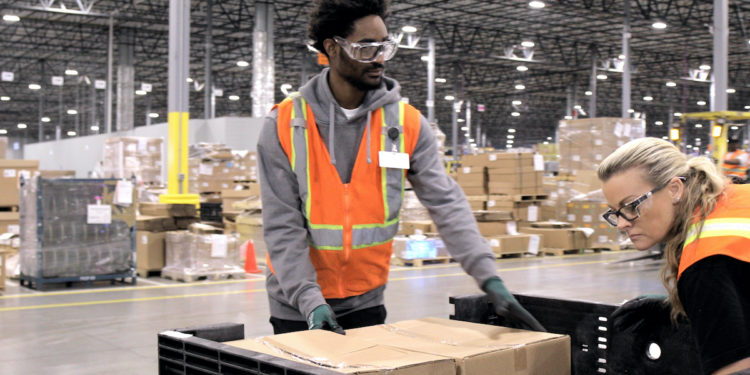Americans Are Facing an Unprecedented Back to School Season. Here’s Why Companies Need to Help Solve the COVID-19 Child Care Crisis.

Almost three quarters of the largest public school districts in America opened this year as remote learning only. (kawee/Adobe Images)
A child care crisis was brewing long before COVID-19 struck the United States earlier this year. Before the pandemic, parents across the country were already faced with a child care market riddled with issues of availability, accessibility, and quality, and priced at an exorbitant cost. JUST’s data showed that on top of that, the vast majority of the largest American companies lacked any child care benefit. The coronavirus crisis has not only exacerbated these existing issues with child care but it has also exposed new challenges and uncertainties for working parents. And the latest hurdle is a messy, unpredictable, and unprecedented back-to-school season.
This year, 73% of the nation’s 100 largest public school districts, serving 8 million children, will only be opening their classrooms remotely. Others are opting for a hybrid approach, involving a combination of in-person and remote learning. Whether learning is fully or partially remote, many children aged 0 to 13 will require adult supervision and after-school care to fill in child care gaps as parents continue to work.
The added problem, though, is that the pandemic has also dramatically changed the child care provider landscape and parental preferences for care.
The state of child care closures during COVID-19
A survey conducted by the Bipartisan Policy Center at the start of the pandemic found that 60% of both center- and home-based child care providers were closed. More recent survey data from the National Association for the Education of Young Children (NAEYC) at the end of the summer found that 18% of child care centers and 9% of home-based child care continued to remain closed. For those child care providers that have weathered the pandemic or have reopened, there are unprecedented costs and considerations.
For instance, providers must simultaneously invest in staff, enhanced sanitization and cleaning procedures, and personal protective equipment while also reducing enrollment and class sizes to promote social distancing. NAEYC survey research from July shows that 70% of providers are incurring substantial costs to adjust their operations to meet these critical health and safety needs. These costs ultimately fall back onto parents, who are already burdened with child care’s high price tag.
The pandemic has impacted parental preferences and needs for child care
At the same time, however, the pandemic has altered parental choices for child care. A Care.com study found that 63% of parents surveyed were somewhat or very uncomfortable sending their child to center-based child care. Instead, 35% of respondents were considering shifting to home-based care. The American public appears to have similar attitudes toward school reopening, too, with 46% agreeing that reopening should come with major adjustments and 31% preferring for schools not to reopen at all, according to a report by the Associated Press-NORC Center for Public Affairs Research.
As working parents juggle closures with their own preferences, earlier survey research from Boston Consulting Group estimated that 60% of them had not found alternative child care or school arrangements. And the need for child care is high for both those parents who are able to work from home and those working in-person. In April, a Bipartisan Policy Center survey of parents with young children found 43% of parents working remotely due to COVID-19 needed some type of child care, while 49% who were “essential” workers – disproportionately women and people of color – required more formal child care services.
Unmet child care needs during the pandemic have disproportionately hurt mothers while increasing costs to their employers
Working mothers have shouldered the brunt of filling these unmet child care needs during the pandemic. The Center for American Progress’ recent analysis of the U.S. Census Bureau’s Household Pulse Survey discovered that millennial mothers were almost three times more likely than fathers to be unable to work as a result of child care and school closures. Working mothers have been making tradeoffs to fully meet their families’ child care needs even before the COVID-19 pandemic, which can result in absenteeism at work, lost wages, or even exits from the labor force altogether. These tradeoffs have significant implications for perpetuating gender inequities and cost families millions each year.
Unmet child care needs impact employers, too. Prior to the pandemic, American employers were estimated to lose $12.7 billion a year due to breakdowns in typical child care arrangements that lead to lower employee productivity and greater absenteeism and turnover. A Brookings researcher recently told Barron’s that school closures will cost the U.S. economy $56 billion per month in lost productivity, as parents navigate both work and caregiving. Over a typical school year, that could amount to $500 billion if schools continue to stay closed.
It’s in companies’ best interest to step up
An overwhelming consensus among parents – 96% of those surveyed earlier this year – is that the government and businesses must act to provide working parents with additional support for child care. JUST Capital’s own polling has found that the American public believes that a one-two punch is needed to tackle issues of childcare provision. Specifically, when we asked who should be responsible for providing a stipend to fund childcare services, 62% of respondents selected either federal or state government.
But in the absence of any federally coordinated response to the COVID-19 care crisis, the responsibility falls on companies to step up to help their working parents fill the gaps in care arrangements as children return to school this fall. Our polling shows that there’s a growing demand from Americans that employers play a role in providing financial support for child care for their workers: 39% of Americans say that employers should be responsible for doing so.
How has corporate America done so far?
Prior to the pandemic, the landscape of company-provided child care generally included three options: on-site child care, subsidies for off-site child care providers, and subsidized backup dependent care, which can be used when existing care arrangements fall through. JUST Capital’s analysis of companies in the Russell 1000 shows that before the pandemic, the vast majority of companies did not provide any type of child care benefit to their working parents. Just 6% of companies provided child care through a center on site, 8% offered subsidized child care, and 15% offered backup dependent care.
The COVID-19 pandemic elicited an additional dependent care response from companies in light of child care and school closures and disruptions to employees’ typical care arrangements: 9% of the companies we evaluated this year instituted or extended their backup dependent care benefit that were specific to the challenges presented by the pandemic. These benefits were a mix of increased backup dependent care support or additional paid time off for employees to deal with care challenges in response to COVID-19.
Of the few companies that added backup dependent care benefits in response to the pandemic, most only offered temporary relief. For instance, Visa temporarily increased the number of maximum backup care visits available to its employees to 20 through its partnership with LifeCare. Microsoft and Google offered extensive increased paid time off benefits to their employees. While still a temporary fix, they provided 12 and 14 weeks, respectively, of additional paid leave for employees to deal with dependent care issues and school closures, surpassing the amount of time given by many of their peers. Although these additions are critical in addressing short-term disruptions to child care, the temporary nature of these provisions is insufficient for coping with the ongoing care needs as children return to school.
Flexible benefits can ease childcare burdens on working parents
Backup dependent care and extended time off do not solve the longer-term complexities of child care needs for fully or partially remote school this fall. Parents who are still working from home, back in the office, or on the frontlines require ongoing child care benefits that are flexible enough to meet their unique situations and preferences.
Companies should consider offering employees more flexible benefits, such as subsidies, stipends, or other financial support that can be used for a variety of dependent care arrangements – ranging from center-based care to family, friend, and neighbor care – that best suit their families. Some companies, like Bank of America and Adobe, provided a more flexible dependent care reimbursement as part of their responses to the pandemic. Bank of America’s benefit allows employees to receive up to $100 a day to go toward the backup care of their choice.
Adobe explicitly states the availability of a care reimbursement that can be used however employees see fit: “If care is not available through the Bright Horizons backup care program, you will be offered the option to secure care from your personal network (e.g., a neighbor, friend or babysitter) and receive a reimbursement of $100 per day.”
The nuanced challenges presented by back-to-school in the time of COVID-19 call for companies to consider creative, equitable solutions to obstacles faced by caregivers of all types, whether they are in corporate positions or on the frontlines.
As companies determine what type of policies work for them, those that take employee benefits seriously should bring the same weight they do to health insurance or retirement to child care policies, because the severity and business-side impacts are on the same level. Whether companies decide to step up and provide robust benefits directly or advocate for a federal solution can be up for debate and will likely vary across companies, but what shouldn’t be up for debate is whether this is an issue that should be prioritized.






